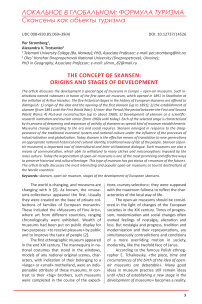The concept of skansen: origins and stages of development
Автор: Stromberg Per, Trotsenko Alexandra V
Журнал: Современные проблемы сервиса и туризма @spst
Рубрика: Локальное в глобальном: формула туризма скансены как объкты туризма
Статья в выпуске: 4 т.9, 2015 года.
Бесплатный доступ
The article discusses the development a special type of museums in Europe - open-air museums. Such in- stitutions named «skansen» in honor of the first open-air museum, which opened in 1891 in Stockholm at the initiative of Arthur Hazelius. The five historical stages in the history of European skansens are offered to distinguish: 1) origin of the idea and the opening of the first skansen (up to 1891); 2) the establishment of skansen (from 1891 until the First World War); 3) Inter-War Period (the period between the First and Second World Wars); 4) Post-war reconstruction (up to about 1960); 5) Development of skansen as a scientific- research institution and tourism center (from 1960s until today). Each of the selected stage is characterized by its process of deepening and expansion of activity of skansens as special kind of museum establishments. Museums change according to the era and social requires. Skansen emerged in response to the disap- pearance of the traditional economic system and national culture under the influence of the processes of industrialization and globalization. Today skansen is the effective means of translation to new generations an appropriate national historical and cultural identity, traditional way of life of the people. Skansen (open- air museums) is important tool of intercultural and inter-civilizational dialogue. Such museums are also a means of communication, which able to withstand to many cliches and misconceptions imposed by the mass culture. Today the organization of open-air museums is one of the most promising and effective ways to preserve historical and cultural heritage. This type of museum has got status of «museum of the future». The article briefly discusses the most interesting and popular open-air museums as tourist destinations of the Nordic countries.
Skansen, open-air museum, stages of the development of european skansens
Короткий адрес: https://sciup.org/140206437
IDR: 140206437 | DOI: 10.12737/14526
Список литературы The concept of skansen: origins and stages of development
- Afanasiev O.E. Skansens of Ukraine as representant of regional types of nature-use//Geography and Tourism. 2011. Iss. 15. PP. 111-119.
- Cont F. From ethnographic museums to the society museums: Franch experience//RGGU Bulletin. Series «Culturology, art history, museology». 2008. Iss. 10/08. PP. 251-256.
- Czajkowski J. An ourline of skansen museologi in Europe//Open Air Museums in Poland. Poznan, 1981. PP. 12-31.
- Jong A. de. Hazelius revisited? Survival of a 19th century idea in the 21th century//20th Conference of the Association of European Open Air Museums. Hungary, August 19-20, 2001. Szententendre, 2001.
- Nordenson E. Skansen during 100 years//Report 15 the Meeting. Skansen 1891-1991. Sweden. Association of European Open Air Museums/Ed. by M. Janson, Chr. Zeuner. Kristianstad, 1993. PP. 51-55.
- Sevan O. Open-air museums in Europe//Observatory of Culture. 2006. Iss. 3. PP. 60-69.
- Tikhonov V. The practice of founding the ethnographic open-air museums in Russia and other countries//Transbaikal State University Journal. 2012. Iss. 9 (88). PP. 3-8.
- Weeda A. Meaningful in open air museum // Interpretation in open air museums // Association of European Open Air Museums. Transcripts from the training seminar held at Weald & Downland Open Air Museums. June 24-26, 1998. UK, 1998.


